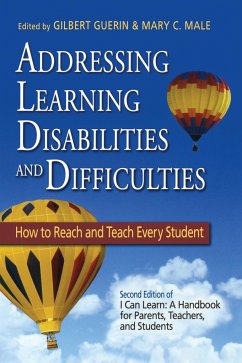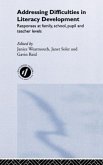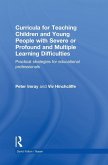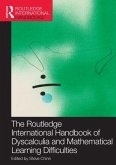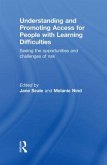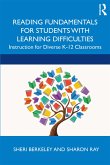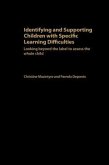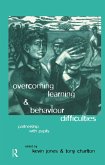Gilbert Guerin, Mary C. Male
Addressing Learning Disabilities and Difficulties
How to Reach and Teach Every Student
Gilbert Guerin, Mary C. Male
Addressing Learning Disabilities and Difficulties
How to Reach and Teach Every Student
- Gebundenes Buch
- Merkliste
- Auf die Merkliste
- Bewerten Bewerten
- Teilen
- Produkt teilen
- Produkterinnerung
- Produkterinnerung
This updated edition of I Can Learn offers the best practices and policies that enable students with learning disabilities to excel in the general education classroom.
Andere Kunden interessierten sich auch für
![Addressing Difficulties in Literacy Development Addressing Difficulties in Literacy Development]() Reid Gavin / Janet Soler / Janice Wearmouth (eds.)Addressing Difficulties in Literacy Development267,99 €
Reid Gavin / Janet Soler / Janice Wearmouth (eds.)Addressing Difficulties in Literacy Development267,99 €![Curricula for Teaching Children and Young People with Severe or Profound and Multiple Learning Difficulties Curricula for Teaching Children and Young People with Severe or Profound and Multiple Learning Difficulties]() Peter ImrayCurricula for Teaching Children and Young People with Severe or Profound and Multiple Learning Difficulties243,99 €
Peter ImrayCurricula for Teaching Children and Young People with Severe or Profound and Multiple Learning Difficulties243,99 €![The Routledge International Handbook of Dyscalculia and Mathematical Learning Difficulties The Routledge International Handbook of Dyscalculia and Mathematical Learning Difficulties]() The Routledge International Handbook of Dyscalculia and Mathematical Learning Difficulties320,99 €
The Routledge International Handbook of Dyscalculia and Mathematical Learning Difficulties320,99 €![Understanding and Promoting Access for People with Learning Difficulties Understanding and Promoting Access for People with Learning Difficulties]() Understanding and Promoting Access for People with Learning Difficulties211,99 €
Understanding and Promoting Access for People with Learning Difficulties211,99 €![Reading Fundamentals for Students with Learning Difficulties Reading Fundamentals for Students with Learning Difficulties]() Sheri BerkeleyReading Fundamentals for Students with Learning Difficulties198,99 €
Sheri BerkeleyReading Fundamentals for Students with Learning Difficulties198,99 €![Identifying and Supporting Children with Specific Learning Difficulties Identifying and Supporting Children with Specific Learning Difficulties]() Pamela DeponioIdentifying and Supporting Children with Specific Learning Difficulties265,99 €
Pamela DeponioIdentifying and Supporting Children with Specific Learning Difficulties265,99 €![Overcoming Learning and Behaviour Difficulties Overcoming Learning and Behaviour Difficulties]() Tony CharltonOvercoming Learning and Behaviour Difficulties288,99 €
Tony CharltonOvercoming Learning and Behaviour Difficulties288,99 €-
-
-
This updated edition of I Can Learn offers the best practices and policies that enable students with learning disabilities to excel in the general education classroom.
Hinweis: Dieser Artikel kann nur an eine deutsche Lieferadresse ausgeliefert werden.
Hinweis: Dieser Artikel kann nur an eine deutsche Lieferadresse ausgeliefert werden.
Produktdetails
- Produktdetails
- Verlag: Corwin
- Seitenzahl: 184
- Erscheinungstermin: 9. November 2005
- Englisch
- Abmessung: 260mm x 183mm x 15mm
- Gewicht: 552g
- ISBN-13: 9781412925617
- ISBN-10: 1412925614
- Artikelnr.: 22105611
- Herstellerkennzeichnung
- Books on Demand GmbH
- In de Tarpen 42
- 22848 Norderstedt
- info@bod.de
- 040 53433511
- Verlag: Corwin
- Seitenzahl: 184
- Erscheinungstermin: 9. November 2005
- Englisch
- Abmessung: 260mm x 183mm x 15mm
- Gewicht: 552g
- ISBN-13: 9781412925617
- ISBN-10: 1412925614
- Artikelnr.: 22105611
- Herstellerkennzeichnung
- Books on Demand GmbH
- In de Tarpen 42
- 22848 Norderstedt
- info@bod.de
- 040 53433511
Gilbert Guerin, PhD, is on the staff of the San Jose State University Foundation where he directs teacher preparation and demonstration projects. Previously he held the position of professor of special education and department chair at San Jose State University. He has also held faculty positions in the schools of Education at the University of California at Berkeley, in Educationaly Psychology at California State University, Hayward and in Psychology at Dominican College, San Rafael, California. He was a school psychologist for more than 10 years and holds teaching credentials in elementary education, secondary education, and special education. He is the author of Informal Assessment in Education; Improving Instruction for Youth at Risk; and Critical Steps in Curriculum Reform and coauthored Bridges to Reading. He is the coauthor of recent articles titled "Confronting the Problem of Poor Literacy: Recognition and Action," "Plans, Predictions, and Frustrations in the Education of a Troubled Youth: Michael′s Story-One of Many," and "Dropout Prevention: a Case for Enhanced Early Literacy Efforts." He is a mentor and trainer with the Monarch Project, University of Illinois at Chicago, and has provided similar services for the Alliance Project at Vanderbilt University. He has developed an online instructional resource site for high school teachers of students who are at-risk for school failure (found at http: //alternativeed.sjsu.edu). He actively supports parent participation in the instructional decisions for children and youth and collaborates with Parent Helping Parents, a family resource center. Mary Male, PhD, is a professor of special education at San Jose State University, where she has taught for twenty-two years. She coordinates a federally funded Alternative Education Teacher Preparation Program. Previously, she was a general education classroom teacher in Grades 4, 5, and 6, and a junior high school resource specialist in special education. She has also been a program administrator and staff development consultant for the California Department of Education. She has helped school districts nationwide plan for inclusive classrooms and is an expert in using technology to create access to the general education curriculum. She is the author of Technology for Inclusion: Meeting the Special Needs of All Students (2003). Recent book chapters include "Computers and Cooperative Learning in Diverse Classrooms" in Cooperative Learning and Strategies for Inclusion by Joanne Putnam (1998) and "Tools for Reconceptualizing the Inclusive Classroom" in New Ways of Lookiing at Learning Disabilities edited by Lou Denti and Patricia Tefft-Cousin (2001). She has presented at conferences nationwide on strategic planning for comprehensive systems of personnel development, cooperative learning, technology and inclusion, and alternative education. She is an Apple Distinguished Educator. She is the parent of a student with disabilities. She is active in her community by serving as a Court-Appointed Special Advocate (CASA) and is a mentor for students in the foster care system who have a dream of a higher education.
Preface
Acknowledgments
About the Editors
1. Introduction
Some Background of Difficulties With Children's Learning and Performance
Complexity of Learning and Performance Difficulties
Basic Assumptions
Approaches to Children's Difficulties in Learning and Performance
Uses, Benefits, and Limitations of Addressing Learning Disabilities and
Difficulties
Parts I and II: Their Content and Purpose
Ways to Use This Handbook
Summary
Part I: Learning Difficulties and Teaching Strategies
2. Strategies to Improve Learning Skills
Listening Comprehension
Ability to Pay Attention
Organizational Skills
Retention and Retrieval of Material
Productivity
Mathematical Computations and Operations
Mathematical Reasoning and Problem Solving
Reading Word Recognition
Reading Comprehension
Summary
Intervention Plan
3. Strategies to Improve Performance Skills
Verbal Expression
Handwriting and Copying
Spelling
Written Expression
Test Taking
Appropriate Social Behavior
Summary
Intervention Plan
Part II: The Special Education Referral Process
4. Referral and Eligibility
Documentation of Adaptations
The Referral Process
The Evaluation Process
Parents' Rights
Eligibility and Specific Learning Disabilities
Summary
5. The Individualized Education Program
Intent of the IEP
IEP Meeting
Content of the IEP Document
The Positive Behavioral Intervention Plan
Placement in Alternative Education Setting
Reviews and Reevaluations
Summary
6. Options for Service Delivery
Continuum of Program Options
Service Delivery Models
Strategies and Programs for School Sites
Summary
Afterword
Glossary
Resource A: Characteristics and Criteria for Identifying Students With
Learning Disabilities, Dyslexia, Attentional Disorders, and Behavioral
Problems
Resource B: Selected Internet Sites
Resource C: Agencies and Organizations
Selected References
Index
Acknowledgments
About the Editors
1. Introduction
Some Background of Difficulties With Children's Learning and Performance
Complexity of Learning and Performance Difficulties
Basic Assumptions
Approaches to Children's Difficulties in Learning and Performance
Uses, Benefits, and Limitations of Addressing Learning Disabilities and
Difficulties
Parts I and II: Their Content and Purpose
Ways to Use This Handbook
Summary
Part I: Learning Difficulties and Teaching Strategies
2. Strategies to Improve Learning Skills
Listening Comprehension
Ability to Pay Attention
Organizational Skills
Retention and Retrieval of Material
Productivity
Mathematical Computations and Operations
Mathematical Reasoning and Problem Solving
Reading Word Recognition
Reading Comprehension
Summary
Intervention Plan
3. Strategies to Improve Performance Skills
Verbal Expression
Handwriting and Copying
Spelling
Written Expression
Test Taking
Appropriate Social Behavior
Summary
Intervention Plan
Part II: The Special Education Referral Process
4. Referral and Eligibility
Documentation of Adaptations
The Referral Process
The Evaluation Process
Parents' Rights
Eligibility and Specific Learning Disabilities
Summary
5. The Individualized Education Program
Intent of the IEP
IEP Meeting
Content of the IEP Document
The Positive Behavioral Intervention Plan
Placement in Alternative Education Setting
Reviews and Reevaluations
Summary
6. Options for Service Delivery
Continuum of Program Options
Service Delivery Models
Strategies and Programs for School Sites
Summary
Afterword
Glossary
Resource A: Characteristics and Criteria for Identifying Students With
Learning Disabilities, Dyslexia, Attentional Disorders, and Behavioral
Problems
Resource B: Selected Internet Sites
Resource C: Agencies and Organizations
Selected References
Index
Preface
Acknowledgments
About the Editors
1. Introduction
Some Background of Difficulties With Children's Learning and Performance
Complexity of Learning and Performance Difficulties
Basic Assumptions
Approaches to Children's Difficulties in Learning and Performance
Uses, Benefits, and Limitations of Addressing Learning Disabilities and
Difficulties
Parts I and II: Their Content and Purpose
Ways to Use This Handbook
Summary
Part I: Learning Difficulties and Teaching Strategies
2. Strategies to Improve Learning Skills
Listening Comprehension
Ability to Pay Attention
Organizational Skills
Retention and Retrieval of Material
Productivity
Mathematical Computations and Operations
Mathematical Reasoning and Problem Solving
Reading Word Recognition
Reading Comprehension
Summary
Intervention Plan
3. Strategies to Improve Performance Skills
Verbal Expression
Handwriting and Copying
Spelling
Written Expression
Test Taking
Appropriate Social Behavior
Summary
Intervention Plan
Part II: The Special Education Referral Process
4. Referral and Eligibility
Documentation of Adaptations
The Referral Process
The Evaluation Process
Parents' Rights
Eligibility and Specific Learning Disabilities
Summary
5. The Individualized Education Program
Intent of the IEP
IEP Meeting
Content of the IEP Document
The Positive Behavioral Intervention Plan
Placement in Alternative Education Setting
Reviews and Reevaluations
Summary
6. Options for Service Delivery
Continuum of Program Options
Service Delivery Models
Strategies and Programs for School Sites
Summary
Afterword
Glossary
Resource A: Characteristics and Criteria for Identifying Students With
Learning Disabilities, Dyslexia, Attentional Disorders, and Behavioral
Problems
Resource B: Selected Internet Sites
Resource C: Agencies and Organizations
Selected References
Index
Acknowledgments
About the Editors
1. Introduction
Some Background of Difficulties With Children's Learning and Performance
Complexity of Learning and Performance Difficulties
Basic Assumptions
Approaches to Children's Difficulties in Learning and Performance
Uses, Benefits, and Limitations of Addressing Learning Disabilities and
Difficulties
Parts I and II: Their Content and Purpose
Ways to Use This Handbook
Summary
Part I: Learning Difficulties and Teaching Strategies
2. Strategies to Improve Learning Skills
Listening Comprehension
Ability to Pay Attention
Organizational Skills
Retention and Retrieval of Material
Productivity
Mathematical Computations and Operations
Mathematical Reasoning and Problem Solving
Reading Word Recognition
Reading Comprehension
Summary
Intervention Plan
3. Strategies to Improve Performance Skills
Verbal Expression
Handwriting and Copying
Spelling
Written Expression
Test Taking
Appropriate Social Behavior
Summary
Intervention Plan
Part II: The Special Education Referral Process
4. Referral and Eligibility
Documentation of Adaptations
The Referral Process
The Evaluation Process
Parents' Rights
Eligibility and Specific Learning Disabilities
Summary
5. The Individualized Education Program
Intent of the IEP
IEP Meeting
Content of the IEP Document
The Positive Behavioral Intervention Plan
Placement in Alternative Education Setting
Reviews and Reevaluations
Summary
6. Options for Service Delivery
Continuum of Program Options
Service Delivery Models
Strategies and Programs for School Sites
Summary
Afterword
Glossary
Resource A: Characteristics and Criteria for Identifying Students With
Learning Disabilities, Dyslexia, Attentional Disorders, and Behavioral
Problems
Resource B: Selected Internet Sites
Resource C: Agencies and Organizations
Selected References
Index

